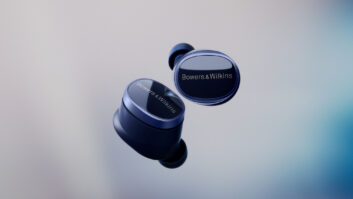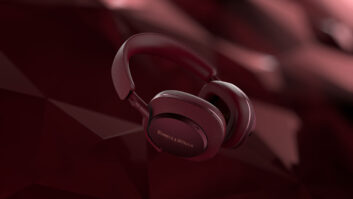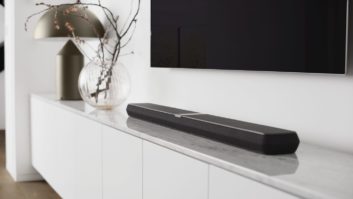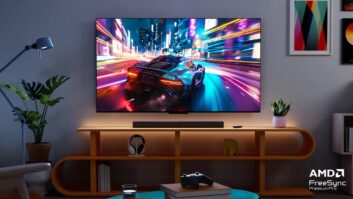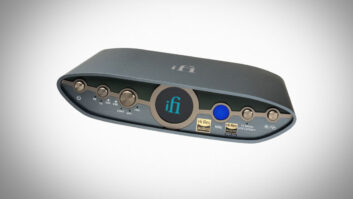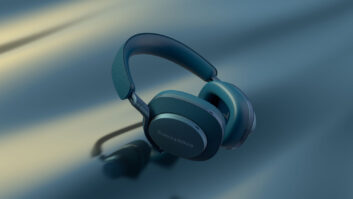Over my years of reviewing AV components, one of the categories that has seen the most significant and regular changes, upgrades, and updates is soundbars.
Initially it felt like soundbars were little more than an afterthought, or a marketing race to say, “Yeah! We have one, too!” But today companies put serious thought and resources into their soundbar design, and have not only increased technology in these bars to raise the performance, they’ve also steadily worked on the style and cosmetics, nimbly added music streaming integration, and found ways to be compatible with the latest immersive audio formats like Dolby Atmos.
Bowers & Wilkins’ (B&W) first foray into soundbars was the company’s Panorama series. The first model bowed in 2009 with a 9-driver design and carried a hefty price tag of $2200, but lacked any HDMI capabilities. This was replaced with the refreshed and updated Panorama 2 in 2013, which retained the same price tag and most of the design and cosmetic elements, but improved driver performance and features, significantly improving low-end reproduction and adding HDMI capabilities.
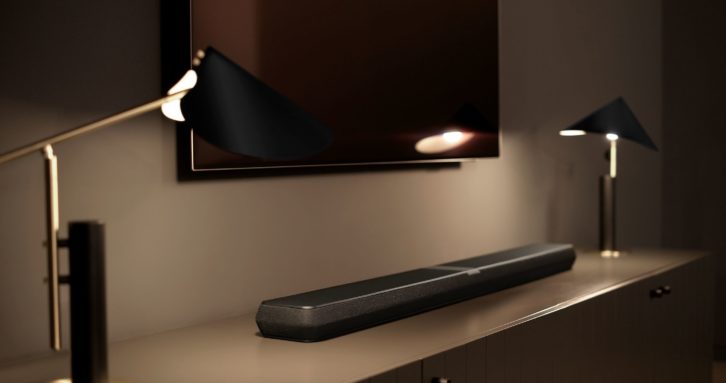
But B&W let the Panorama line languish for years, instead working on its new Formation wireless series with a bar costing far less — $1299 — and including a very stylish design. However, Formation seems more concerned in its music streaming and multi-room features, not offering any immersive audio capabilities and lacking even a single HDMI input — an unforgivable omission for a modern-day soundbar.
You can only imagine members of B&W’s team — and the company’s dealers! — tearing their hair out, begging for the company to produce a modern, competitive product that delivers B&W performance along with current must-have features.
“Guys! It’s been almost ten years! When are we gonna get back into the fight?! Put me in, coach! I’m ready to play!”
Well, it’s game time.
Introducing the latest member of B&W’s soundbar family: the Panorama 3.
While the name is the same, very little else is. The Panorama 3 is a complete redesign and shares very little with its ancestors short of the name, and retails for a more customer-friendly price of $999. It’s pretty clear the assignment was to deliver a soundbar that could stand on its own, work with modern, larger flat panel displays, be as simple as possible to operate, and — most importantly — serve as the company’s first Dolby Atmos model.
Or, you know, deliver a bar that offers B&W dealers a very direct and viable competitor to the Sonos Arc.
Design
Once you’ve unpacked the Panorama 3, it’s immediately apparent this is an entirely different product. While it is some 2.5 inches wider than the old model, has more drivers (13 versus 9), and features significantly more amplification (400 watts versus the old 175 watts), it weighs less than half of the Panorama 2. Some of this can no doubt be attributed to new/different driver designs, but a lot comes from eliminating the old model’s rigid (and heavy) stainless-steel casing.
While not the artistic statement of the 2 — or even the Formation — the new 3 is more intelligently designed to integrate with modern flat panel displays. With a height of just 2.5 inches, you’ll likely be able to set it in front of a tabletop display without it interfering with the screen. And at 46.6 inches wide, it looks like it belongs with larger screens, and it mated quite nicely with my 65-inch Sony. It has a 5.5-inch depth to accommodate the upfiring Atmos drivers and two 4-inch bass/sub drivers.
Visually, the 3 has a clean and reserved yet refined look. It may be a weird comparison, but the bar has the classic, timeless good looks of a black tuxedo. It’s not flashy and trying to call attention to itself; it just sits there confident that it looks good. The front and sides are wrapped in a dark charcoal fabric with a bit of beveling to the edges to give it some visual texture, and the top is covered in a similar dark microperf metal grille. There are some trim details on the top edges in a titanium color that give it a bit of panache, and a center gloss-black strip atop the bar housing provides some basic capacitive touch controls that illuminate when you approach the bar. There are no zero distracting lights or indicators on the front of the bar, making it all but disappear beneath your display.
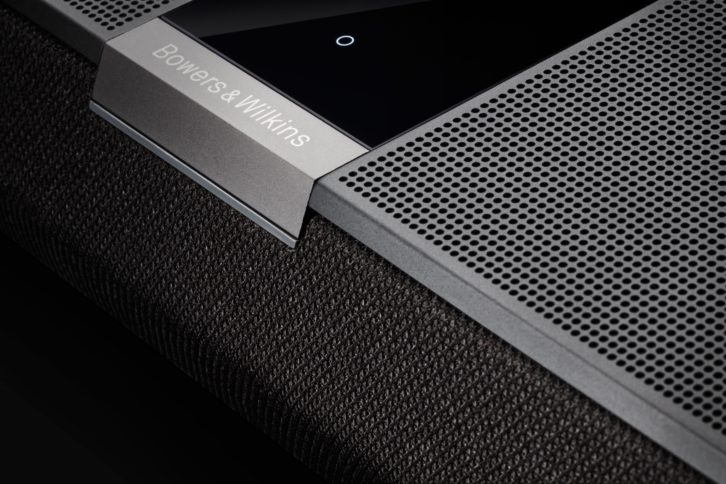
While B&W describes the bar as “Discrete Dolby Atmos 3.1.2” there are actually 13 drivers under the hood. In the past, B&W touted driver designs such as “aluminum dome Nautilus tube-loaded tweeters” ported down from the company’s reference 800 Series speakers; however no such verbiage accompanies this. The new Panorama features three .75-inch titanium dome tweeters — another significant improvement as old models featured just a single tweeter — and six 2-inch bass/midrange drivers in pairs for left/center/right, two more 2-inch bass/mid drivers angled in the top for height effects, and two 4-inch sub/bass units.
This is an all-in-one, standalone soundbar, meaning there is no subwoofer or rear speakers either included or available as optional add-ons. I asked if there might be a way to add these at some point in the future and B&W commented, “There is no way to add rears or a sub, now or ever. It’s not been designed for that purpose.” So, there you go.
Installation and Setup
The Panorama 3 includes a wallmount that adds about an inch of depth to the unit and has hit-or-miss screw spacing for hitting studding, meaning there’s a fair chance you’ll need to use anchors. I opted for just tabletop mounting it, and it easily slid under my 65-inch Sony LED’s screen.
The bar has a recessed section on the back that houses all connections, making them accessible even if wall mounted. There is a single eARC capable HDMI, Toslink optical digital, RJ45 network, and detachable power cord. (A USB-C connection is reserved for Service.) At this price, I would have liked at least one additional HDMI connection and an analog input.
There isn’t much in the way of setup instructions included with the unit — a more thorough manual is available online — short of a Quick Start Guide that tells you to connect power and an HDMI cable and points you to downloading the Bowers & Wilkins Music App (iOS and Android).
After installing the app and creating an account (ugh!), the app walks you through the process of connecting to the Panorama 3, adding it to your system, joining a Wi-Fi network (2.4 GHz only), and naming it.
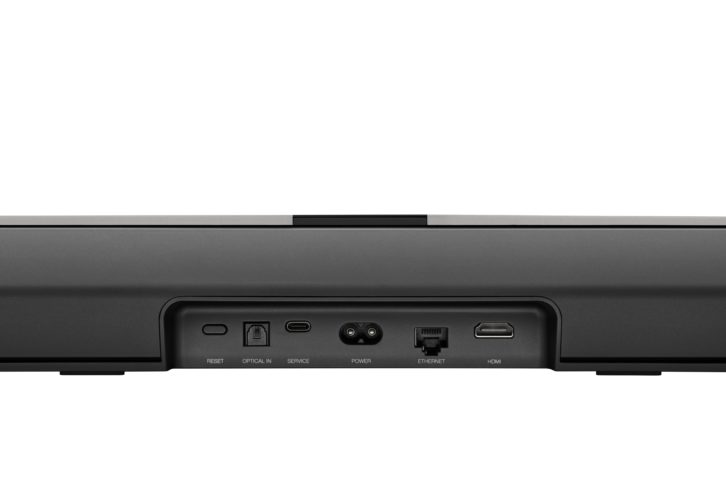
The app is also your portal for adding, accessing, and controlling the currently supported music services that include Deezer, last.fm, Qobuz, SoundCloud, TuneIn, Tidal, NTS, and Dash. Atmos streaming via Tidal isn’t currently supported, though B&W hopes to add that later this year. (“We also plan to offer support for Atmos Music on other streaming providers this year.”) The Panorama 3 also supports Apple AirPlay2, Spotify Connect, and Bluetooth 5.0 aptX streaming.
While multiroom listening is capable via AirPlay2 now, a free firmware update will be rolled out shortly that will enable it to use the same wireless technology found in B&W’s Formation series, making it more part of that family of products. (Room-to-room streaming of the Panorama’s HDMI input won’t be supported.)
Opening the settings tab for the bar, you can see its network details, name the HDMI and Toslink inputs, enable Amazon Alexa, and learn the volume commands from a remote control, and access the bar’s sole audio adjustments: bass and treble.
This is a major gripe for me. I understand that KISS (Keep It Simple, Stupid) was a clear design mandate, but with a premium bar from a product with B&W’s pedigree, I expect some ability to tailor the sound. A soundbar — particularly one that does Dolby Atmos and pseudo-surround — is highly influenced by the room it’s installed in, so offer some ability to tweak it for the best performance in that room. Certainly, some microphone-based room correction is the best, but the ability to adjust the surround and height channel levels should be considered requisite.
And how about a dialog lift or center-channel adjustment? “I can’t hear the dialog” is literally the biggest complaint customers want addressed when buying a soundbar. B&W’s response was, “We’ve designed the Panorama 3 to be as simple as possible to use. It does offer Treble and Bass adjustment, but that’s all.” Sigh…
There is also no ability to select the sound processing used. B&W says that stereo music is played back in 3.1 (L/C/R plus sub) without any additional processing or height channels. Dolby signals — whether 2.0 or 5.1 — are fed into the Dolby Audio upmixer and use all channels, with Atmos content handled natively. I did like how the app clearly displays the Dolby Atmos logo when an Atmos signal is received.
The bar doesn’t support any DTS codecs, which may or may not be an issue. If the bar is primarily used for streaming or cable/satellite watching you should be okay, but if you connect a Blu-ray or movie server you might not. I tried watching the new 4K reissue of The Godfather via my Kaleidescape Strato and was greeted with an earful of screeching, staticky white noise after discovering DTS was the only audio option available. The solution requires going into your display’s audio output settings and making some tweaks (turning the eARC output off and setting output to PCM only in my case), but then you are just getting a 2-channel signal. Oh, and if you forget to go back into your display and then re-enable the settings, then you won’t get Atmos or Dolby Surround any longer. So, KISS that…
Performance
Let’s admit that we’ve all been burned by the promise of HDMI’s ARC connection long enough to acknowledge that eARC seems to be incredibly stable and — dare I say? — reliable. The same mostly holds true here as my Sony TV and the Panorama 3 played really nice together, with the TV’s volume controls smoothly controlling the bar and providing the correct level feedback. The one hiccup I experienced was when going from streaming audio back to TV sound, which required selecting the “Start Listening HDMI” option in the app. Sometimes, in order to get this choice to reappear, I’d need to quit and reopen the app, and twice I had to restart the bar before audio would resync with the display.
I listened to loads of content, both music and movies, with and without Atmos encoding, and I can definitively say the Panorama 3 can absolutely deliver an immersive surround experience.
With 2-channel music — anything played from the B&W Music App — the presentation is clear, but fairly constrained to the bar. Without any side drivers or processing, the 3.1-channel presentation just doesn’t have a lot of width. Having three tweeters across the front does provide a sense of left/right and some spaciousness, but the soundstage feels about 4 feet wide.
Sonically, things definitely expand when listening to anything that is upmixed or actually Atmos encoded. Tidal has a growing library of albums mixed in Atmos, and using the app in my Sony TV delivered some really great and immersive audio.
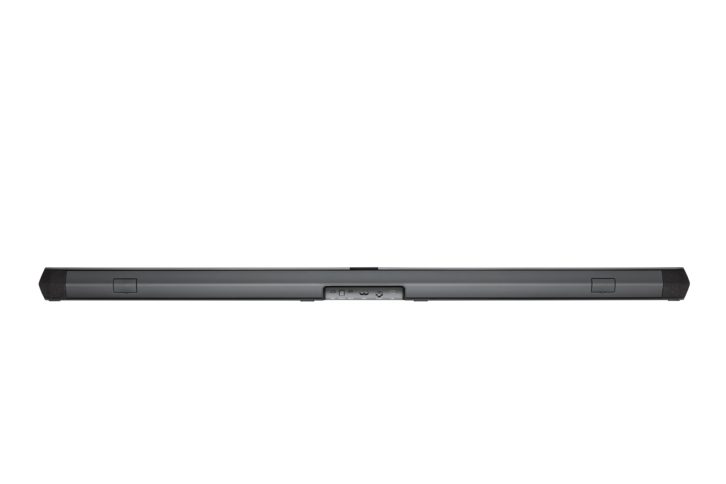
Kraftwerk’s “3-D The Catalogue” is a really creative mix that captures the band’s techno-pop style, and instruments and voices are spread well wide and above the bar with lots of localization. The Doors’ “Riders on the Storm” is another song that has received a nice Atmos mix, with thunder and rain sounds mixed high up into the ceiling, Ray Manzarek’s piano floating out in space, and some far more noticeable menacing whispers from Jim Morrison underneath the main lyrics. Another great Atmos audio demo is “Heroes” from Moby’s Reprise with Mindy Jones vocals that just breathe and subtly echo into the room, giving the song a beautifully haunting quality.
Of course, video watching is likely going to be the Panorama 3’s primary role and it can really deliver an impressively cinematic and immersive experience, with the upfiring drivers believably placing sounds overhead.
When Lucasfilm remastered The Empire Strikes Back for 4K HDR with Dolby Atmos, they really pushed the sound mix to 11, and the opening battle on Hoth has tons of overhead effects, from probes whizzing past, to the rebel base collapsing, to the mechanical noises of AT-AT’s and snow speeders whizzing by, and the Panorama 3 delivered them all.
Another scene I love to check for discrete height placement is the very opening of Kong: Skull Island. Even while the credits roll, you should hear the sounds of planes clearly zipping across the ceiling, flying from the top of the room to the back dogfighting, and the Panorama 3 didn’t disappoint. In my room this scene also delivered sound that reached well out to the sides and back corners of the room, making the experience feel much larger.
When you think “immersive sound mix” you might not think about the horror film IT, unless you’ve seen it. The movie opens with the creepy voices and laughter of children wide and around the room and up into the ceiling that sets the vibe. Even better/creepier is when the Losers visit the house on Neibolt Street, which is filled with eerie atmospherics and creaking, voices, and scratching movements you’ll swear are coming from right overhead.
Pick any movie filled with good height effects — A Quiet Place II, Ready Player One, Moonfall — and the Panorama 3 will deliver the goods, really expanding the experience and convincingly placing sounds above you. While there is certainly some width to the presentation, in my room it did a better job placing sounds off to the sides of me and into back corners of the room more than making sounds feel far left/right of the screen.
In my experience, standalone soundbars nearly always struggle to deliver convincing bass, and with a frequency response rated down to 43 Hz, the Panorama 3 is capable of delivering some low end, but whether it is enough will depend on expectations. I found the bass on music playback to be more than adequate, but I was left wanting more in movies. Things like the opening explosion in Unbroken or the big engine roar of the Batmobile in The Batman just didn’t have that tactile and visceral quality you get from a sub that can plumb those lowest octaves.
While the inability to add a sub or surrounds might be forgivable if this was the most impressive-sounding, standalone soundbar ever (which it isn’t; that title still belongs to Sennheiser’s AMBEO), I question the decision from a sheer business perspective. Why eliminate the opportunity for you and your dealer channel to add on and sell what can be another $1500 to $2000-plus in additional products?
Ultimately, Bowers & Wilkins has produced an impressive-sounding standalone bar, and a welcome update to the Panorama line. Sure, I think they have left room for upgrades and improvements for a Panorama 4, but for people who primarily watch movies looking for the simplest way to significantly improve the sound of their display today, it is certainly worth auditioning.
800-370-3740 / BowersWilkins.com
Kudos: Atmos playback delivers nice immersion with convincing height effects; simple to set up and use
Concerns: Inability to add a subwoofer or surround speakers; virtually no sound adjustments; no DTS support; limited inputs; non-cinematic bass
Product Specs:
- Discrete Dolby Atmos 3.1.2
- 13 total drivers — three tweeters, six mid/bass, two Atmos height drivers, two bass drivers — powered by 400 watts power
- Frequency Response 43 Hz–48 kHz
- Decodes Dolby Atmos, Dolby TrueHD, Dolby Digital+, LPCM
- Compatible with Bowers & Wilkins Music App (iOS and Android)
- Bluetooth AptX, Spotify Connect, Airplay 2
- Amazon Alexa enabled with built-in microphone
- Connections: HDMI eARC, Toslink digital audio in, RJ45 Ethernet, USB-C (service connection), detachable power cable
Dimensions: 2.5 x 46.6 x 5.5-inches (H x W x D); 14.3 pounds
This article originally ran on residentialsystems.com
About the Author
John Sciacca is a principal with Custom Theater and Audio, in Myrtle Beach, South Carolina. In his free time, he blogs prolifically about the CE industry and is publisher for cineluxe.com.
See also: Hey Sonos! Company Debuts Entry-Level Soundbar, Voice Control For Music, And New Roam Colors




